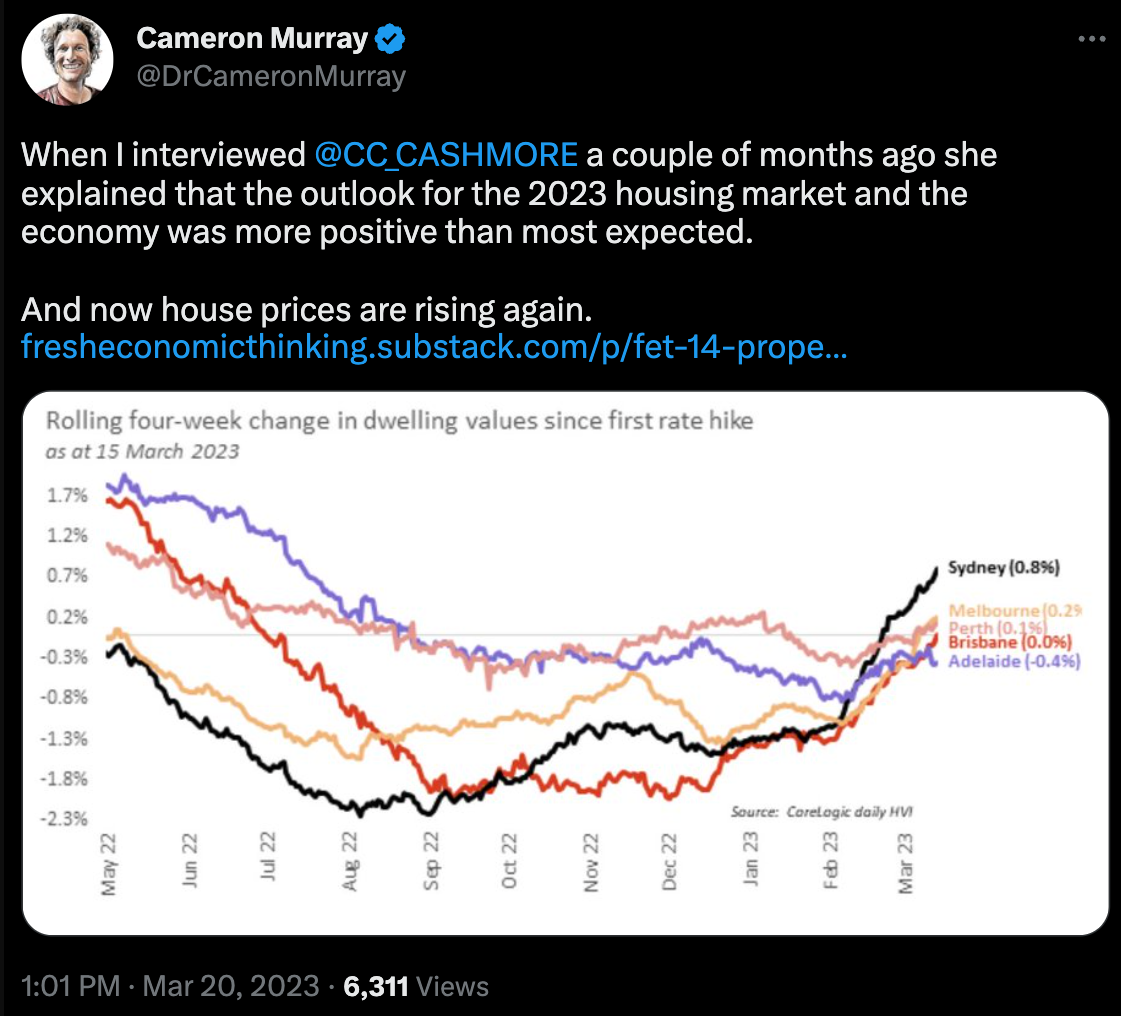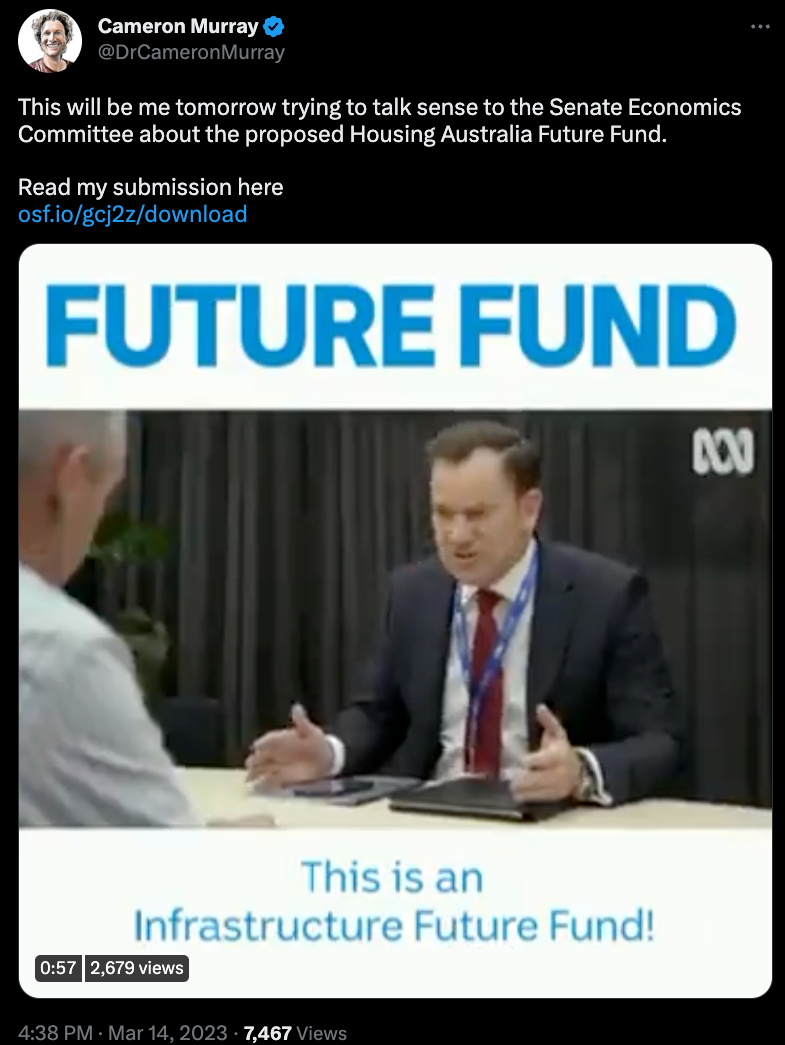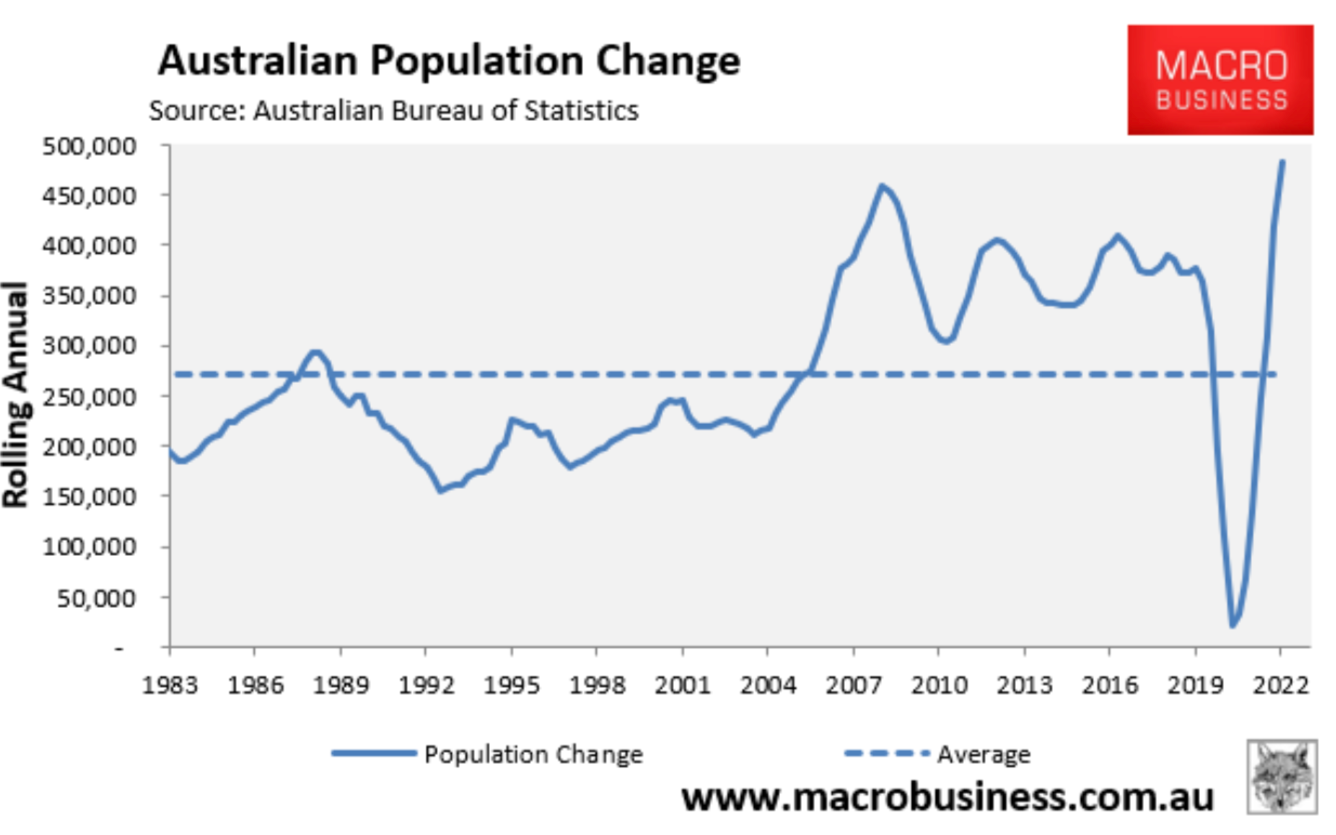This week I was interviewed by Catherine Cashmore for the Land Cycle Investor, where we discussed the likely impact of Australia’s record immigration boom on the nation’s housing market (among other topics).
Below is Catherine’s introduction, followed by the YouTube interview. Have a listen. It was a great yarn.
There is an immigration bomb sitting underneath the Australian property market, and it’s threatening to put a rocket under property prices as we head into the winner’s curse phase of this cycle (between 2024–26).
Last week, the Chief Executive of the Property Council of Australia, Mike Zorbas, presented to the Senate Committee on Housing Affordability in Australia.
He didn’t mince his words either.
Zorbas told the committee that Australia is:
‘160,000 homes behind the national starting line over the next decade.
‘We’ve got a real supply cliff coming and that applies in the four capital cities which are likely to be the focus of population growth for the country for the next 40 or 50 years.
‘That is a very, very worrying circumstance when we already know that right now, even before that drop off in supply we’re already experiencing pretty radical problems with affordability.
‘As that gets worse over the next two years, and most policy and decision makers have essentially chosen to bury their heads in the sand about this looming cliff.
‘We’re accidentally sleepwalking into what is going to be a critical period of time here.’
I’m not so sure there’s anything accidental about it.
But neither am I convinced that the housing unaffordability crisis has its roots in a simple low supply/high demand equation.
Certainly, this would be the findings of Prosper Australia’s Speculative Vacancy reports.
Year-on-year, the report has evidenced 10s of thousands of properties held off the market (vacant for 12 months or more) in the Greater Metropolitan Region of Melbourne alone!
(Note: The latest report will launch soon and show similar findings. You can stay up to date here.)
As it is, under current tax policy, investors that withhold primary land and dilapidated housing from use are often rewarded with substantial unearned incomes (capital gains) in the boom phases of the property cycle.
For example, for owners that do not hold a lot of debt on a property, there can be little incitive to renovate accommodation to meet legislative tenancy requirements (or sell the home to someone that will) when prices are rocketing upwards.
This is due to governmental failure to collect the economic land rent (i.e., the ‘capital gains’) society generates through public investment in social services.
I’m talking about the type of new infrastructure that attracts speculative demand into housing markets that have limited well-facilitated land to meet that need.
The argument being; if we moved the tax base off income and productivity (which is taxed very highly) and instead put it onto land and monopoly rents (that are minimally taxed in comparison), it would incentivise more owners to employ their vacant land and housing into use.
Still, we live in a boom/bust economy choreographed around the real estate market. As it is, there are not enough properties on the rental market to meet demand — and arguably, not enough listed for sale either!
These dynamics have started to produce a modest upturn in median values through the first quarter of the year.

So, what’s the solution?
Well, according to the property lobby — and every government official for that matter — the only way to solve the housing unaffordability crisis is to construct more housing.
And this is what the government spruiks it’s going to do, following its election promise to build one million new, well–located homes over five years — starting in 2024.
Except, to do so, it’s not going to put a shovel in the soil, acquire land, or employ home builders.
Rather, the bill proposes to invest $10 billion in non-home financial assets.
Dr Cameron Murray has done an excellent job of breaking down the jargon:
‘Satire and reality have met.
‘In the political comedy show Utopia there is a scene where Rob Sitch’s character explains to a political staffer that building infrastructure today IS fixing the future, whereas a fund is just a risky, expensive, and unnecessary waste.
‘A great example is the Future Fund, which spent $500 million just in fees last year in order to lose $2.4 billion of value.
‘Do we really think that spending $20 million in fund management fees per year in a Housing Fund and $5 million on research, to risk losing billions is better than just building new homes?
‘This fund has been portrayed as a low-risk long term politically-insulated funding source.
‘It is exactly the opposite — it is a high-risk fund that defers tough housing spending decisions to future politicians who now have an excuse to limit housing funding to $500 million.
‘Another perversity is that the fund is designed “to create a funding source”. Yet, the legislation just says that Treasury will credit the fund with $10 billion. Where is that money coming from?
‘Why doesn’t it need a funding source?….
‘Perhaps instead of spending tens of millions a year managing the financial fund and doing further research, we could pay the Future Fund board to be mystery shoppers and simply go out in the property market and buy new dwellings, sometimes in bulk, at a good price from private developers, be it land and house packages, townhouses, or apartments.
‘This would put housing equity into the fund, increase the rate of new housing construction, and immediately grow a pool of housing to allocate to state public housing agencies, CHPs or, my favourite, by lottery to non-homeowner households.’

You can read more of Dr Cameron Murray’s excellent analysis here.
But what has been completely ignored in the mainstream media and government is criticism over what’s producing such rampant demand in the first place.
I’m talking about the Immigration time bomb.
‘Big Australia’ take two.
The fact is, a record number of migrants landed in Australia in 2022, pushing the country’s population growth to a new high of nearly 500,000 people!

That’s huge!
It’s far more than experts predicted in the Intergenerational Report.
They thought it would be around 235,000 people annually.
And assuming that stays consistent, Australia’s population is expected to increase by 13.1 million people over the next 40 years — equalling a population of around 39 million in total.
Think the population of the east coast capitals (Sydney, Melbourne, and Brisbane) being added to the country — and you get some idea of the intended outcome.
It’s some 20,000 higher per year than the average net overseas migration of the past 15 years.
Even so, projecting what the population will be 40 years into the future is pure speculation. Who’s to know what lies ahead — especially considering forecasts of war at the peak of this cycle, as I discussed with both Fred Harrison and David Murrin a week or so ago.
However, in the shorter term, you don’t need to be Einstein to know what it’s going to do to property markets.
It’s almost as if the government caught wind that median prices were plummeting — after all, median values had the biggest fall in the shortest period of time over the past 12 months due to panic produced by the fastest rate hiking cycle in history — and decided the only way to save an economy and financial system pinned on rising land values is to pump immigration to record levels to exacerbate the supply crisis and manufacture a housing boom!
And that’s exactly what I’m forecasting — a housing boom between 2024–26.
I’m not the only one, either.
So too is Leith Van Onselen, the co-founder of the excellent economics website MacroBusiness, where he writes under the penname Unconventional Economist.
Leith has previously worked as an economist at the Australian Treasury, Victorian Treasury, and Goldman Sachs.
With a strong background in economic policy and financial sector regulation, he’s not afraid to cut through the BS bias narrative that dominates the mainstream media and tell it like it is.
I caught up with Leith yesterday to break down what the current immigration policies mean for Australia and each state’s property market — and to look at the potential outcomes.
We also discuss:
- The gas cartel’s stranglehold on the Australian economy
- The dynamics in NZ’s property market that have produced a *crash* in median values
- Why Leith thinks markets are on the upwards swing
- Advice for investing if you don’t want to fall subject to disastrous economic policy decisions that promise to transfer wealth from renter to rentier
All this and much more!
Tune into the interview below.

